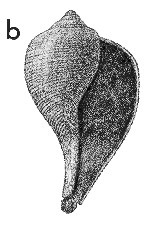
Revised descriptions of New Zealand Cenozoic Mollusca from Beu and Maxwell (1990)

 | Revised descriptions of New Zealand Cenozoic Mollusca from Beu and Maxwell (1990) | 
|
  (Pl. 15b): GS9805, F44/f9501, Coal Brook Station, Wendon Valley, Southland, Duntroonian (GNS) |
Beu & Maxwell (1990): Chapter 10; p. 159; pl. 15 b.
Classification: Ficidae
Description: Moderately large for genus (height 50-75 mm), fig-shaped, with low, weakly stepped spire of slightly concave outline. Protoconch low dome-shaped, of 2.75 smooth whorls, apex narrowly coiled, terminal sculptured zone not distinguishable on the rather poorly preserved material (all from sandstone). Teleoconch of about 4.5 whorls, each largely enveloped by succeeding whorl; sutural ramp wide, slightly concave. Last whorl very large, elongate, swollen and strongly convex adapically, but contracting gradually to a long, curved neck abapically. Sculpture of many fine, low, closely spaced spiral cords, alternating regularly in strength on most specimens (but quite variable in detail), crossed by many low, weak, irregular axial costellae, larger shells typically with low, irregular folds on ramp and periphery. Aperture pyriform, with a moderately long, widely open siphonal canal, weakly deflected to left, no fasciole. Inner lip with a thin callus smear over columella, extending above top of aperture and visible as a smooth zone around lower third of penultimate whorl. Outer lip thin, simple, retracted to suture, with a very shallow sinus over sutural ramp.
Comparison: The unnamed species is similar to the Australian basal Miocene (Longfordian) species Ficus altispira (Pritchard, 1896) (Fossil Bluff, near Wynyard, northern Tasmania), and apparently has an identical protoconch, but F. altispira has consistently finer and closer spiral cords and much more regular, fine, close axial threads than the New Zealand material. F. imperfecta (Altonian, Oamaru) was based on a very immature specimen from Target Gully Shellbed, but a much better specimen from South Oamaru shows that it is a low-spired, very finely sculptured species with a raised cord forming a slight shoulder angle, and low, rather long, narrowly crested axial folds situated regularly and extending down onto the last whorl (of a small specimen). A similar, apparently also unnamed species is reasonably common in Altonian and Clifdenian siltstone at Clifden, and differs from F. imperfecta in its narrower form and its still finer spiral sculpture. F. parva, described from "Old Rifle Butts", Cape Wanbrow, Oamaru (Whaingaroan?) and recorded from several Kaiatan to Runangan localities in North Otago and South Canterbury, is a consistently small species (largest seen, from Lome, Kaiatan, 33 mm high) with very fine sculpture, a tall spire and a large, low protoconch of 3.0 whorls, of which only the last quarter-whorl has spiral threads.
Ficus (gender feminine) is well-known in warm, shallow waters around tropical reefs and on the inner to mid-shelf and this corresponds well with its shallow-water occurrences in New Zealand. Its prey has still not been identified, and earlier claims that it predated echinoids have not been substantiated.
Distribution: Whaingaroan(?), Duntroonian-Waitakian; Wharekuri Greensand, Wharekuri; Otekaike Limestone, Waitaki Valley; Chatton Formation, Wendon Valley.
Cite this publication as: "A.G. Beu and J.I. Raine (2009). Revised
descriptions of New Zealand Cenozoic Mollusca from Beu and Maxwell (1990). GNS
Science miscellaneous series no. 27."
© GNS Science, 2009
ISBN
978-0-478-19705-1
ISSN 1177-2441
(Included with a PDF facsimile file
copy of New Zealand Geological Survey Paleontological Bulletin 58 in CD version
from: Publications Officer, GNS Science, P.O. Box 30368 Lower Hutt, New
Zealand)